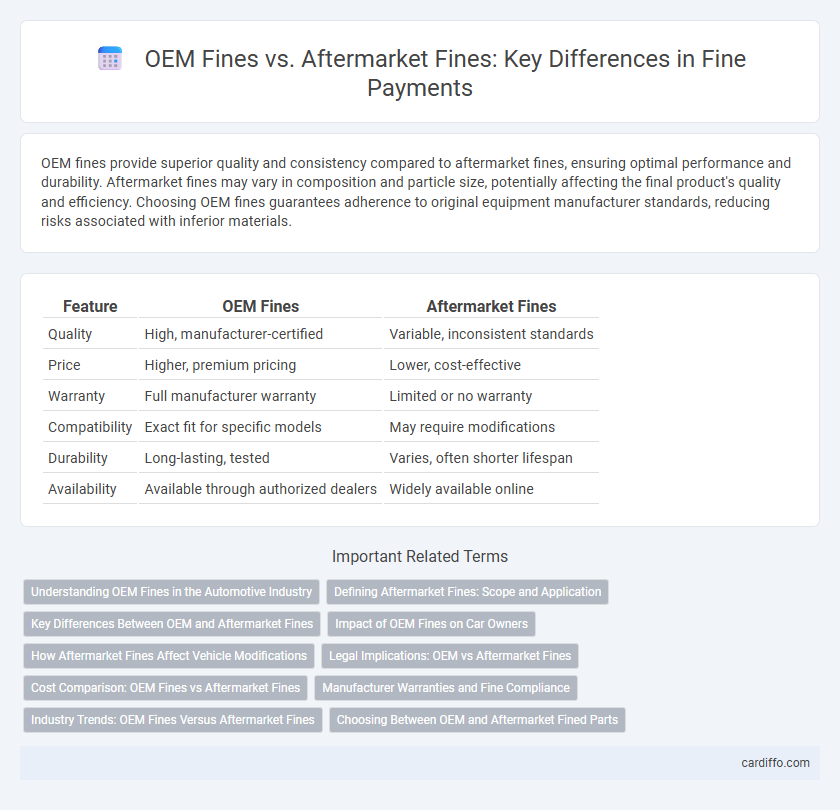OEM fines provide superior quality and consistency compared to aftermarket fines, ensuring optimal performance and durability. Aftermarket fines may vary in composition and particle size, potentially affecting the final product's quality and efficiency. Choosing OEM fines guarantees adherence to original equipment manufacturer standards, reducing risks associated with inferior materials.
Table of Comparison
| Feature | OEM Fines | Aftermarket Fines |
|---|---|---|
| Quality | High, manufacturer-certified | Variable, inconsistent standards |
| Price | Higher, premium pricing | Lower, cost-effective |
| Warranty | Full manufacturer warranty | Limited or no warranty |
| Compatibility | Exact fit for specific models | May require modifications |
| Durability | Long-lasting, tested | Varies, often shorter lifespan |
| Availability | Available through authorized dealers | Widely available online |
Understanding OEM Fines in the Automotive Industry
OEM fines in the automotive industry refer to the original equipment manufacturer particles used during the production process, ensuring high-quality material consistency and optimal performance in vehicle components. These fines are engineered to strict specifications, providing superior compatibility and durability compared to aftermarket fines, which may vary in composition and quality. Understanding OEM fines helps manufacturers maintain vehicle safety standards and enhances engine efficiency by reducing wear and tear.
Defining Aftermarket Fines: Scope and Application
Aftermarket fines refer to precision-ground abrasive particles used in non-original equipment manufacturer (OEM) products, primarily in automotive, industrial, and consumer goods applications. These fines are engineered to meet specific performance criteria for surface finishing, cleaning, or material removal, distinct from OEM fines that adhere to original manufacturer specifications. The scope of aftermarket fines includes compatibility with diverse materials and cost-effective solutions, enabling wide application in repair, maintenance, and customization processes.
Key Differences Between OEM and Aftermarket Fines
OEM fines adhere to strict regulatory standards and undergo rigorous quality control to ensure compatibility and safety with original products. Aftermarket fines vary widely in quality and may not meet the same material specifications or regulatory compliance, leading to potential performance and safety issues. Key differences include material consistency, quality assurance, and guaranteed product fitment, with OEM fines offering higher reliability for end-users.
Impact of OEM Fines on Car Owners
OEM fines often result from strict compliance measures imposed by manufacturers to ensure vehicle safety and environmental standards, directly affecting car owners through higher repair costs and mandatory service requirements. These fines can lead to increased expenses as only authorized dealers are allowed to perform certain repairs or replacements, limiting cost-effective alternatives. The impact on car owners includes potential delays in vehicle maintenance and increased dependence on OEM parts, raising overall ownership costs.
How Aftermarket Fines Affect Vehicle Modifications
Aftermarket fines significantly impact vehicle modifications by imposing stricter regulations that affect the installation and use of non-OEM parts. These fines often discourage enthusiasts and repair shops from utilizing aftermarket components, which can limit customization options and increase overall maintenance costs. Compliance with aftermarket fine policies is critical to ensure legal modifications and maintain vehicle safety standards.
Legal Implications: OEM vs Aftermarket Fines
OEM fines typically result from violations related to manufacturing defects or non-compliance with regulatory standards, leading to stricter legal scrutiny and higher penalties. Aftermarket fines often stem from unauthorized modifications or using non-certified parts, which can void warranties and trigger liability issues. Regulatory agencies prioritize OEM compliance, but increased enforcement targets aftermarket products that compromise safety and environmental regulations.
Cost Comparison: OEM Fines vs Aftermarket Fines
OEM fines typically cost more than aftermarket fines due to strict manufacturing standards and original brand warranty coverage. Aftermarket fines offer a budget-friendly alternative but may vary in quality and longevity, influencing overall long-term expenses. Evaluating total cost of ownership reveals OEM fines provide consistent performance, while aftermarket options require careful selection to avoid higher replacement costs.
Manufacturer Warranties and Fine Compliance
OEM fines typically align with stringent manufacturer warranties ensuring full compliance with original equipment specifications and preserving warranty validity. Aftermarket fines may vary in quality and often risk voiding manufacturer warranties due to non-compliance with original fine tolerances and regulations. Ensuring compliance with OEM standards is critical to maintaining both product integrity and warranty protection in fine applications.
Industry Trends: OEM Fines Versus Aftermarket Fines
OEM fines typically exhibit higher purity and consistent particle size distribution, driving their preference in precision manufacturing sectors such as automotive and electronics. Aftermarket fines, often more cost-effective, vary widely in quality, influencing their suitability for less demanding applications or budget-sensitive projects. Industry trends indicate a growing demand for OEM fines due to stringent quality control standards and increasing emphasis on product reliability and performance.
Choosing Between OEM and Aftermarket Fined Parts
Choosing between OEM and aftermarket fined parts depends on factors like quality, warranty, and cost-effectiveness. OEM fined parts offer precise fit and reliability due to their manufacturer standards, while aftermarket options provide a more affordable choice with a broader selection. Evaluating durability, compatibility, and long-term performance is essential for making an informed decision.
OEM Fines vs Aftermarket Fines Infographic

 cardiffo.com
cardiffo.com